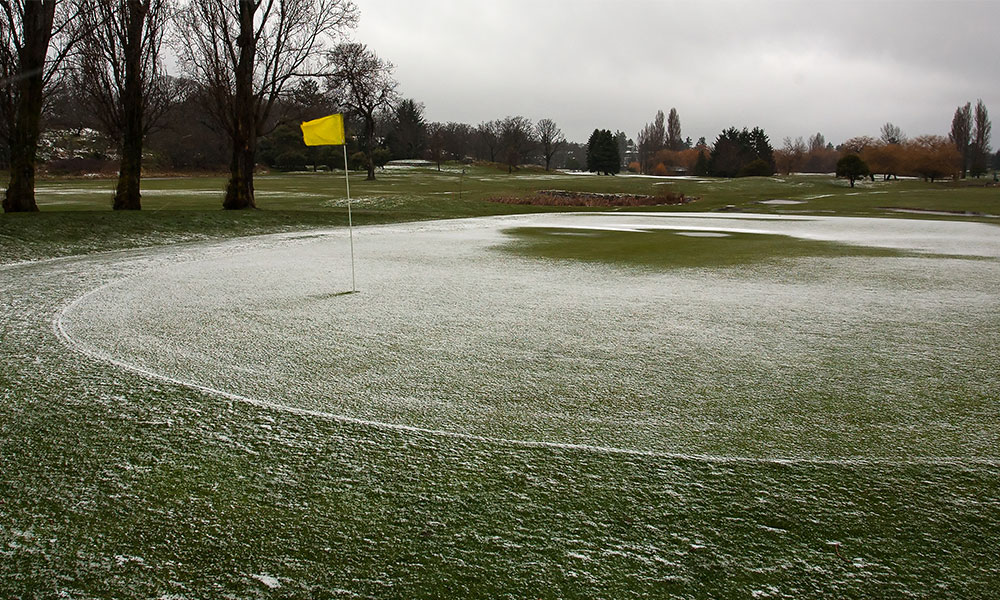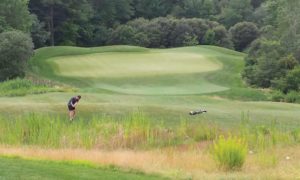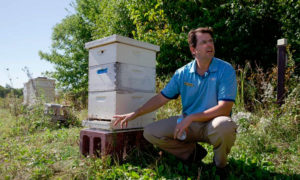It’s winter and the golf course they care for may be shut down, but that doesn’t mean superintendents aren’t keeping busy during the cold weather months.
Indeed, winter is a great time for catching up with chores that have been put off during the busy open months. Superintendents still have the opportunity to get to work on the playing area, providing the course isn’t buried under two feet of snow. Even if they can’t get onto the course, there’s lots of in-house tasks as well as research and planning for the next season. Just because you aren’t mowing grass doesn’t mean you can kick back and relax.
Michigan Golf Course Superintendents Association

“There is a ton of off season work that happens at every course, many golfers may not understand or know about it but every superintendent does. Most dial back to a 40-hour work week in the winter up here,” observed Adam Ikamans, executive director of the Michigan Golf Course Superintendents Association. “Some examples are equipment tear down and maintenance, course accessories repair, reel sharpening, educational opportunities and conferences, snow removal, staff training, tree removal, on course projects and more.”
White Cliffs Country Club in Massachusett
Lianne Larson superintendent at White Cliffs Country Club in Massachusetts, uses the winter months to prepare for the upcoming season by scheduling contracted work, ordering supplies, reviewing hiring needs and working on equipment and course supplies. “We address any maintenance that we can do on the course such as tree work, drainage issues and pond side maintenance. Staffing levels drop down to about 35 percent of our in-season crew.”

She continued, “We try to address all tree work, work on the pond edges, and if weather permits, we will tackle drainage and small course projects. Myself, and our team, are also responsible for all the snow removal for 358 housing units to include all roadways, walkways, and driveways. Depending on the winter weather this can be a massive undertaking.” Indeed, and you thought mowing grass was a chore.
Larson said winter starts for White Cliffs usually the middle of December. “Winters end usually around the third week in March. We will head out on the course and do a thorough spring clean-up. We clean up from the winter storms (we are located directly on Cape Cod Bay). If we have experienced any major nor’easters this clean up can be very involved. Wind damage is common for us in the winter. We also begin to address any bunker maintenance and, if temperatures allow, we begin cutting and rolling, greens, tees, and fairways. Often the club will have some sort of capital project we might address; hydro raking the ponds, a bridge replacement, finishing a green rebuild, or bunker replacement project.”
Larson and her staff begin discussing the upcoming season as soon as they conclude the previous season. “This is a great time to review and discuss what we did well and what we could change or improve for the upcoming year.”
The Club at Viniterra in Virginia

Ryan Dwyer, superintendent at The Club at Viniterra in Virginia, said that even in the mid-Atlantic and upper Southern states, winter does come calling. “Since we have Bermuda grass on all surfaces but greens we don’t have to mow for a few months. We spend a lot of time cleaning up leaves, edging cart paths, adding sand to bunkers, and cleaning up over grown areas. We cut back a few employees. Most of our summer help is high school or college students so they are only here for a few months.”
In the winter, Dwyer and his reduced staff spend a lot of time blowing leaves and edging cart paths. “We make our own tee markers so they get sanded and re-painted every winter. We also paint our fairways in the winter. As soon as it’s dry enough we get that out.”
Dwyer quipped, “With all the work that needs to be done, I never know when winter starts. It seems like we go from one big task to the next. I guess I know winter is here when I’m getting sick of being cold. After a few hard frosts our Bermuda turns brown, so that’s a good indicator.”
Winter signals its conclusion when the grass starts turning green. Said Dwyer, “At that point, we better have all our pre-emergent out and be ready to start another summer.. If something didn’t work or worked great the year before you normally know within a few weeks or months. We are constantly talking to other superintendents and are trying to better ourselves and the course.”
Winter also offers some time and decompress. “During the winter, we take some time to relax from the previous summer,” said Dwyer. “The job takes a back seat and I try to make some time to hunt, travel and see family in other states.”
Silo Point Country Club
Brett Richards, superintendent at Silo Point Country Club in Connecticut, uses the winter months to prepare for the next season by making a new golf schedule and arranging maintenance practices around it. Also, it is a time to look back on past practices and make adjustments; i.e. chemicals/fertilizer, employees and cultural practice.
“We lay our seasonal staff off in November and the winter it’s my assistant and myself,” said Richards. “We manage to do tree work, drainage projects and clean-up to the course in the winter as the weather allows. “For us, winter typically starts in December and ends at the end of March. The latter is typically when the weather gives way and “cabin fever” really hits the membership. Our first priorities are to clean up any winter damage, fix sand traps, limbs/debris figure on our first mow and aerify as much as we can to try and get ahead.”
Red Tail Golf Club
Bobby Landers, superintendent at Red Tail Golf Club in Massachusetts believes winter “is a great time to reflect back on all of the past year’s challenges and try to develop a plan to stay ahead. “It is a great time to do this as we have much more available time for this, and planning for the upcoming season is a big priority. Due to budget reasons and the weather change we cut staff. I cut down to a few essential staff, assistant superintendents, a mechanic, and myself.”
If Landers has easy access to the course because of no or a little snow cover, he spends a lot of time on tree work, trimming, cleaning up any limbs that have fallen and/or removing trees.
Observed Landers, “Winter ends when the snow melts. When the new season begins there is a fair amount of debris to clean up. We also assess greens for any winter damage, top dress and seed any spots that may need them. It really depends on how everything comes out of winter, on where you’ll be directing your attention.”
Related: Why Hire a Golf Course Management Company?
Tunxis Plantation Country Club
Steve Onofrio, superintendent at Tunxis Plantation Country Club on Connecticut, uses the down time during the winter to review his staffing for the coming season. “I see who will be coming back for another season and who else new that I can add to my crew. Especially within the past couple years, it’s been difficult it is to find help. I would much rather go into the spring knowing what I have for staff then scrambling just before the season starts.”
Onofrio’s staff in winter consists of four employees, down from 18 during peak season. “The four are salary and are on all year long. I only keep hourly employees from the end of March to Thanksgiving.” With what staff he does have, he spends “a lot of time” during the cold weather months doing tree work, pruning, chipping, stump grinding, etc., when the ground is frozen enough.
“Winter starts typically when the first snow falls, but if there’s no snow, it’s when we have regularly low temps averaging 45 or lower. Before that happens we clean up the leaves, cut tall grass, and bring in all course items such as ball washers, trap rakes and tee markers.”
Onofrio said for him, winter ends once most of the snow has melted off or there are warmer temps above 45. “I will not bring staff back until late March regardless of the weather so I can stay within the labor budget even if golf can be played. When winter is over and the new season begins we then assess the conditions of the course and see what is playable and what we need to do to get it ready. Blowing off greens, tees and fairways, and removing any debris is a huge part of the new season. Bringing out new course supplies such as tee markers, new flags and flag sticks, bunker rakes, etc.”
Onofrio tries to decompress during the winter. Open season is stressful and constant during the golf season is, especially when maintaining a 45- hole golf club. “Although there is some reflection and planning, I would rather enjoy some downtime and be with my family. During the golf season I take very little, if any time, off.”

Midwest Association of Golf Course Superintendents
Luke Cella, Executive Director of the Midwest Association of Golf Course Superintendents, said winter is a time to review programs and procedures that “occur during the busy summer months”. The winter changes a superintendent’s routine and even mindset, he added. “The work that needs to be accomplished can be scheduled with only the occasional interruption of snow removal. Most superintendents will lose most of their part-time help through the winter months keeping only a few key employees on hand to help with winter tasks. Even a reduction in labor offers a respite for a superintendent.”
Cella said, “There are certain things that mark the changing of seasons and prepping for the winter months; winterizing the irrigation system, laying off staff, prepping snow removal equipment and finishing early orders,” observed Cella. “While there is not a set date for winter to begin, the Thanksgiving holiday seems to be the first real respite when superintendents can take more than a couple of days off and not have to worry about the course.” When winter starts is dependent on the weather rather than a calendar; “sometimes it creeps in like this year and other years it will begin suddenly when cold weather begins and stays,” said Cella.”
Cella had words of advice to superintendents: “Take care of yourself during this time; start some good habits and carry them into the season, whether it’s exercise, managing your diet, and even getting to the doctor(s) for checkups and staying involved in your children’s lives. Take the time for you and your family without giving work a second thought.”
John Torsiello lives in Connecticut and has won a number of awards for is writing. He loves everything golf and plays frequently at numerous courses, notably Canaan Country Club and Blue Fox Run.

























